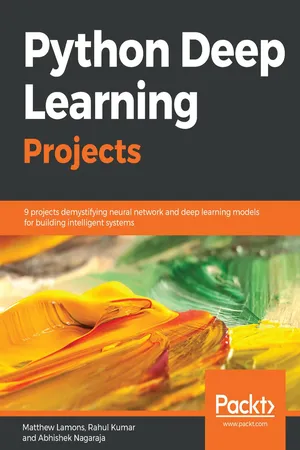
Python Deep Learning Projects
9 projects demystifying neural network and deep learning models for building intelligent systems
Matthew Lamons, Rahul Kumar, Abhishek Nagaraja
- 472 pages
- English
- ePUB (adapté aux mobiles)
- Disponible sur iOS et Android
Python Deep Learning Projects
9 projects demystifying neural network and deep learning models for building intelligent systems
Matthew Lamons, Rahul Kumar, Abhishek Nagaraja
À propos de ce livre
Insightful projects to master deep learning and neural network architectures using Python and Keras
Key Features
- Explore deep learning across computer vision, natural language processing (NLP), and image processing
- Discover best practices for the training of deep neural networks and their deployment
- Access popular deep learning models as well as widely used neural network architectures
Book Description
Deep learning has been gradually revolutionizing every field of artificial intelligence, making application development easier.
Python Deep Learning Projects imparts all the knowledge needed to implement complex deep learning projects in the field of computational linguistics and computer vision. Each of these projects is unique, helping you progressively master the subject. You'll learn how to implement a text classifier system using a recurrent neural network (RNN) model and optimize it to understand the shortcomings you might experience while implementing a simple deep learning system.
Similarly, you'll discover how to develop various projects, including word vector representation, open domain question answering, and building chatbots using seq-to-seq models and language modeling. In addition to this, you'll cover advanced concepts, such as regularization, gradient clipping, gradient normalization, and bidirectional RNNs, through a series of engaging projects.
By the end of this book, you will have gained knowledge to develop your own deep learning systems in a straightforward way and in an efficient way
What you will learn
- Set up a deep learning development environment on Amazon Web Services (AWS)
- Apply GPU-powered instances as well as the deep learning AMI
- Implement seq-to-seq networks for modeling natural language processing (NLP)
- Develop an end-to-end speech recognition system
- Build a system for pixel-wise semantic labeling of an image
- Create a system that generates images and their regions
Who this book is for
Python Deep Learning Projects is for you if you want to get insights into deep learning, data science, and artificial intelligence. This book is also for those who want to break into deep learning and develop their own AI projects.
It is assumed that you have sound knowledge of Python programming
Foire aux questions
Informations
Object Detection Using OpenCV and TensorFlow
Object detection intuition
- PVANET: Deep but Lightweight Neural Networks for Real-time Object Detection, arXiv:1608.08021
- R-CNN: Rich feature hierarchies for accurate object detectio...
Table des matières
- Title Page
- Copyright and Credits
- Dedication
- Packt Upsell
- Contributors
- Preface
- Building Deep Learning Environments
- Training NN for Prediction Using Regression
- Word Representation Using word2vec
- Building an NLP Pipeline for Building Chatbots
- Sequence-to-Sequence Models for Building Chatbots
- Generative Language Model for Content Creation
- Building Speech Recognition with DeepSpeech2
- Handwritten Digits Classification Using ConvNets
- Object Detection Using OpenCV and TensorFlow
- Building Face Recognition Using FaceNet
- Automated Image Captioning
- Pose Estimation on 3D models Using ConvNets
- Image Translation Using GANs for Style Transfer
- Develop an Autonomous Agent with Deep R Learning
- Summary and Next Steps in Your Deep Learning Career
- Other Books You May Enjoy